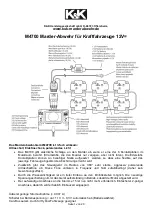
12
User's Guide ADI-8 DD © RME
6.6 Input ADAT/TDIF (Copy Mode)
By means of the SOURCE button, ADAT and TDIF are available as signal sources in the left
part as well. The ADI-8 DD thus turns into a unique ADAT to TDIF and TDIF to ADAT con-
verter, a digital patch bay and signal distributor. These two source formats are notified with a
yellow LED, because they are the main inputs for the right part ( the ADAT/TDIF to AES/EBU
converter), for which they are still available as inputs.
In this operating mode, which is called
Copy Mode
due to its identical source and destination
format, the input signal can be forwarded to a same format without having to change cables
externally. The mathematical equation is
(2 x ADAT In or 2 x TDIF In) to (2 x ADAT Out plus 2 x TDIF Out)
In other terms: The ADAT or TDIF input signal appears in parallel at the ADAT and TDIF out-
puts. And the MAIN and AUX ports can be used to pass through / distribute up to 16 channels
at the same time.
In addition to the already described feature of signal distribution, the ADI-8 DD thus also works
as a patch bay, because the ADAT and TDIF devices connected to the ADI-8 DD can exchange
data directly among each other without re-connecting cables. An ADAT optical or TDIF input
signal is being output at two ADAT optical and two TDIF ports at the same time.
Please take a look at the block diagrams on page 7 and 30. They show the whole signal routing
inside the ADI-8 DD in a clear way, also for this
Copy Mode
.
The sample rate converter is a part of the AES/EBU inputs, so when selecting ADAT/TDIF it
is still only available to the AES inputs. The AES inputs (including the SRC) can also be
used by the right part of the ADI-8 DD if necessary.
If the Copy Mode is active, the DS mode can be activated manually with the button for the
sampling frequency. There is a reason for this: normally, the 8 channel input signal of the
ADAT or TDIF MAIN input is copied to both outputs MAIN/AUX (splitter). But if a Sample Split,
S/MUX or Double Wire signal is present at the ADAT or TDIF input, also the data of the AUX
input has to be passed on to the AUX output for full transmission of 8 channels. In other terms:
16 channels are being forwarded 1:1.
In order to make use of all 16 TDIF and ADAT channels in Copy Mode, DS has to be acti-
vated, even if the source carries only Single Speed signals.
The level display then works like in Sample Split operation. Two channels are being displayed
on one LED (1+2, 3+4 etc.).
Note:
For a bi-directional format conversion ADAT/TDIF set up the left part as ADAT to TDIF,
the right part as TDIF to ADAT converter. See notes on page 15, and remarks on operation
modes 10.7/10.8 on page 22.
Emphasis
The AES/EBU and TDIF interface of the ADI-8 DD support Emphasis. Please note that an Em-
phasis indication will not be stored or processed on the sound when doing digital transfers be-
tween AES/EBU or TDIF and ADAT, because the ADAT standard does not include Emphasis.













































